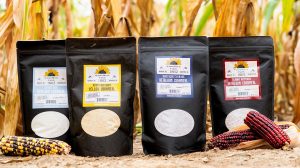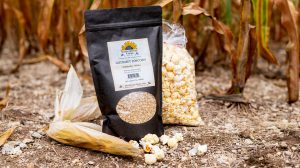The Birding Farmer: Growing Birdseed
I’ve been fascinated by birds since I was a young boy, and my very first 4-H project was on Ohio birds. I drew a specimen of each new bird we came across on early Saturday morning bird walks. Finding them in the wild, studying the way they looked and moved, a glimpse of something rare felt magical. I didn’t really want to do the project at first, but I walked away with what became a lifelong interest in birding. Figures.
Things didn’t come full circle until much later, in 2001, when I lived in Maine where a lot of my friends liked to watch birds. They paid attention to the avian life around them in a way I’d never really seen people do before. They put out feeders and kept logs of which birds came when. The birds they watched were almost a part of the community – welcome guests that were long awaited and well met.
I couldn’t help but join in. I went and bought myself a feeder and filled it with a store-bought mix of sunflower kernels and other miscellaneous seeds. We noticed that while much of the seed did get eaten, some seeds the birds didn’t like at all. We started to dig into how seed mixes are made.
Beth Cole, a good friend and now my business partner, loved camping in the woods and listening to the sounds of birds. Her late mother, Barb, was also a big influence on her birding hobby, sharing her knowledge and love of bird watching. Beth and I were talking one day, and she asked if I could grow black oil sunflower seed – the main ingredient in almost all birdseed, a crop that I thought would grow readily on my family farm in Ohio.
I must admit, I was overconfident, I thought I could grow anything. So, I said sure, let’s do it. And that’s how SchoolHouse Farms came to be!
I started growing sunflowers to feed birds. We started with two acres six years ago, and that’s blossomed (excuse the pun) into what will be over 300 acres next Spring.
What’s up with SchoolHouse Farms Birdseed?
Birdseed is not just the common black oil sunflower that you’re probably thinking of. It often includes white stripe sunflower, millet (red and white), cracked corn, milo (which is a terrible bird seed, even birds throw it on the ground, but it’s often used as filler to save costs), safflower, even hulled sunflower seeds, which removes the outer casing while leaving the kernel, generally leaving less mess in the yard.
I learned how to make bird seed by studying mixes we were already using, as well as looking at what birds liked and what they’d leave in the feeder or spill on the ground. As birders ourselves, we want to attract the biggest variety, so we pay close attention to what many different birds are interested in.
The secret to a wide variety of birds at your feeder? Top quality mix. We call our premium mix “Berwick Blend”, named after the village in Maine, where it all started. It is a mixture of black oil sunflower seeds, white stripes sunflower seeds, sunflower kernels, white millet, cracked corn, safflower, and a little bit of soy oil, which gives the blend a high fat content. Using this, I guarantee birds will be bombing that feeder over anything else. With this mix, I’ve seen Cardinals, American Goldfinch, Nuthatches, Wrens, Chickadees, Blue Jays, Purple finches, Gross beaks, Bluebirds and Woodpeckers near our place in Maine.
The type of feeder you use can also affect what birds you attract. In Maine, I use a tube feeder- a clear plastic tube with pegs that birds can roost on and feed out of all around. Beth has four or five bird feeders including platform and tray feeders. One secret? She likes to attract Baltimore Orioles with grape jelly and an orange. Blue Jays, on the other hand, like the larger seeds and nuts so you want to feed them a larger sunflower seed, like white stripes sunflower seeds, or add in something like peanut pick outs.
Tips on Squirrel Proofing a Bird Feeder?
You can try your best to make a squirrel-proof bird feeder, but it’s tough, those critters are whiley. There’s a fairly decent method that works where you put a PVC tube in the ground and then put your feeding tube inside of it. It makes a barrier that’s harder for the squirrels to get around.
Being an engineer, my mind never stops working on how we could be doing more. We decided to experiment with growing safflower this year. Safflower is not common in Ohio, it’s more popular in the further West in states like Utah and North Dakota. I’m using it in my birdseed mix, so we knew we wanted it to be part of our farm in 2020.
What’s the Future of Birdseed?
While we’re still refining and perfecting our bird seed blends and grow methods, we’re also getting into pressing sunflower seeds for oil. Sunflowers grow the highest oil content per acre of any crop. The sunflowers we grow at SchoolHouse have upwards of 48% oil content, which means almost half the weight of what I grow is oil. High oleic sunflower oil (like we grow) is extremely healthy. We’re currently working with a partner to press our sunflower oil, but I’m excited to take on the challenge of doing it ourselves soon. I’m currently designing the extrusion head, which we’ll have machined locally.
As we get larger, we’re also working on a piece of equipment that will allow us to seamlessly create unique blends of birdseed, where we can dial up specific ratios of seeds, nuts and oils that can be used to attract different birds in different regions. Having that functionality would allow us to experiment with an even wider range of bird seeds, and really tailor the blend to attract the biggest range of birds.

History of Heirloom Corn at Schoolhouse Farms
October 10, 2024

Health Benefits of Popcorn
October 10, 2024